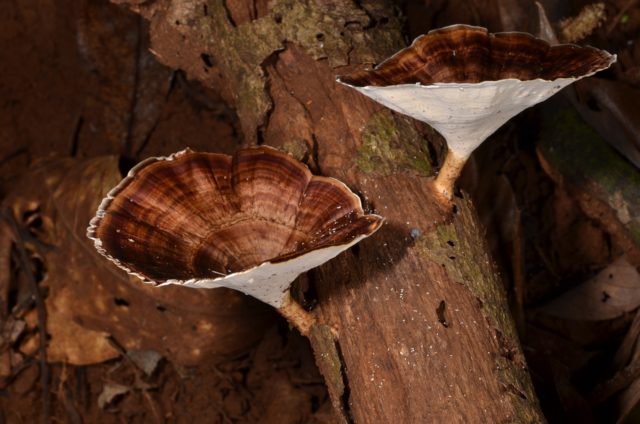Content
Microporus yellow-leg is a representative of the mushroom kingdom, belonging to the genus Micropora from the Polyporov family. Latin name - Microporus xanthopus, synonym - Polyporus xanthopus. This mushroom is native to Australia.
What does the yellow-pegged microporus look like?
The hat of the fruiting body outwardly resembles an open umbrella. The yellow-pegged microporus consists of a spreading top and a refined leg. The outer surface is dotted with small pores, hence the interesting name - microporus.
This variety is characterized by several stages of development. A white spot appears on the wood, indicating the emergence of the fungus. Further, the size of the fruiting body increases, the stem is formed.

Due to the specific color of the leg, the variety received the second part of the name - yellow-pegged
The thickness of the cap of an adult specimen is 1-3 mm. The color ranges from brownish shades.
Where and how it grows
Australia is considered the birthplace of the yellow-pegged micropore. A tropical climate, the presence of decaying wood - that's all it needs to develop.
Is the mushroom edible or not
In Russia, the yellow-pegged microporus is not used for food. Unofficial sources indicate that the indigenous people of Malaysia use the pulp to wean small children.
Due to its unusual appearance, the fruit body is popular with craft lovers. It is dried and used as a decorative element.
Doubles and their differences
The yellow-leg microporus has no similar species, so it is very difficult to confuse it with other representatives of the fungal kingdom. The unusual structure and bright colors are individual, which makes the microporus special.
Some external similarity is observed in the chestnut tinder fungus (Picipes badius). This mushroom also belongs to the Polyporov family, but belongs to the Pitsipes genus.
Grows on fallen deciduous trees and stumps. Appears in regions with damp soils. It can be found everywhere from the end of May to the third decade of October.
The average diameter of the mushroom cap is 5-15 cm, under favorable conditions it grows up to 25 cm. The funnel-shaped shape is the only similarity between the yellow-pegged micropore and the chestnut tinder fungus. The color of the cap in young specimens is light, with age it becomes deep brown. The central part of the cap is slightly darker, the shade is lighter towards the edges. The surface is smooth, shiny, reminiscent of varnished wood. During the rainy season, the cap feels oily to the touch. Creamy white fine pores form under the cap, which acquire a yellow-brown tint with age.

The flesh of this mushroom is tough and overly elastic, so it is difficult to break it with your hands.
The leg grows up to 4 cm in length and up to 2 cm in diameter. The color is dark - brown or even black. The surface is velvety.
Due to its rigid elastic structure, the mushroom has no nutritional value. Polypores are harvested and dried to create crafts.
Conclusion
Microporus yellow-leg is an Australian mushroom that has practically no analogues. It is not used for food, but it is used in interior design.








